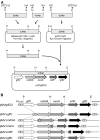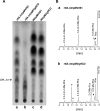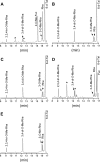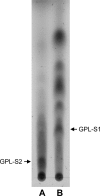Characterization of the fucosylation pathway in the biosynthesis of glycopeptidolipids from Mycobacterium avium complex
- PMID: 17526707
- PMCID: PMC1951812
- DOI: 10.1128/JB.00344-07
Characterization of the fucosylation pathway in the biosynthesis of glycopeptidolipids from Mycobacterium avium complex
Abstract
The cell envelopes of several species of nontuberculous mycobacteria, including the Mycobacterium avium complex, contain glycopeptidolipids (GPLs) as major glycolipid components. GPLs are highly antigenic surface molecules, and their variant oligosaccharides define each serotype of the M. avium complex. In the oligosaccharide portion of GPLs, the fucose residue is one of the major sugar moieties, but its biosynthesis remains unclear. To elucidate it, we focused on the 5.0-kb chromosomal region of the M. avium complex that includes five genes, two of which showed high levels of similarity to the genes involved in fucose synthesis. For the characterization of this region by deletion and expression analyses, we constructed a recombinant Mycobacterium smegmatis strain that possesses the rtfA gene of the M. avium complex to produce serovar 1 GPL. The results revealed that the 5.0-kb chromosomal region is responsible for the addition of the fucose residue to serovar 1 GPL and that the three genes mdhtA, merA, and gtfD are indispensable for the fucosylation. Functional characterization revealed that the gtfD gene encodes a glycosyltransferase that transfers a fucose residue via 1-->3 linkage to a rhamnose residue of serovar 1 GPL. The other two genes, mdhtA and merA, contributed to the formation of the fucose residue and were predicted to encode the enzymes responsible for the synthesis of fucose from mannose based on their deduced amino acid sequences. These results indicate that the fucosylation pathway in GPL biosynthesis is controlled by a combination of the mdhtA, merA, and gtfD genes. Our findings may contribute to the clarification of the complex glycosylation pathways involved in forming the oligosaccharide portion of GPLs from the M. avium complex, which are structurally distinct.
Figures






References
-
- Aspinall, G. O., D. Chatterjee, and P. J. Brennan. 1995. The variable surface glycolipids of mycobacteria: structures, synthesis of epitopes, and biological properties. Adv. Carbohydr. Chem. Biochem. 51:169-242. - PubMed
-
- Bardarov, S., S. Bardarov, Jr., M. S. Pavelka, Jr., V. Sambandamurthy, M. Larsen, J. Tufariello, J. Chan, G. Hatfull, and W. R. Jacobs, Jr. 2002. Specialized transduction: an efficient method for generating marked and unmarked targeted gene disruptions in Mycobacterium tuberculosis, M. bovis BCG, and M. smegmatis. Microbiology 148:3007-3017. - PubMed
-
- Belisle, J. T., K. Klaczkiewicz, P. J. Brennan, W. R. Jacobs, Jr., and J. M. Inamine. 1993. Rough morphological variants of Mycobacterium avium. Characterization of genomic deletions resulting in the loss of glycopeptidolipid expression. J. Biol. Chem. 268:10517-10523. - PubMed
Publication types
MeSH terms
Substances
LinkOut - more resources
Full Text Sources
Molecular Biology Databases

